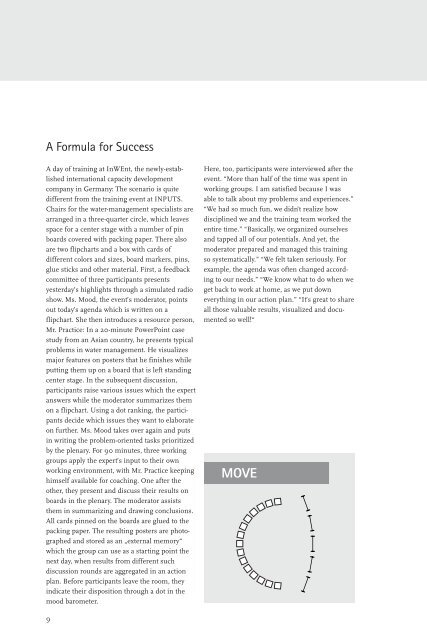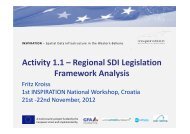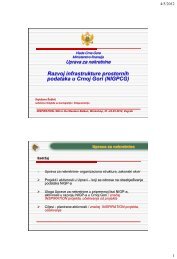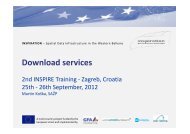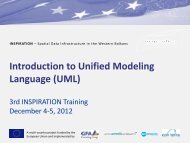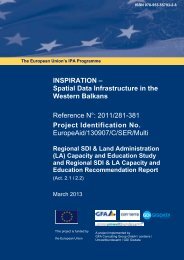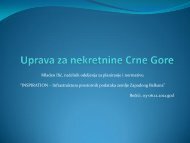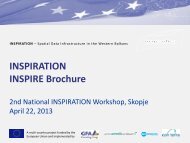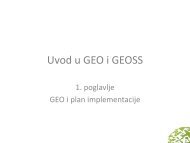MOVE - Moderation and Visualization for Group ... - INSPIRATION
MOVE - Moderation and Visualization for Group ... - INSPIRATION
MOVE - Moderation and Visualization for Group ... - INSPIRATION
Create successful ePaper yourself
Turn your PDF publications into a flip-book with our unique Google optimized e-Paper software.
A Formula <strong>for</strong> Success<br />
A day of training at InWEnt, the newly-established<br />
international capacity development<br />
company in Germany: The scenario is quite<br />
different from the training event at INPUTS.<br />
Chairs <strong>for</strong> the water-management specialists are<br />
arranged in a three-quarter circle, which leaves<br />
space <strong>for</strong> a center stage with a number of pin<br />
boards covered with packing paper. There also<br />
are two flipcharts <strong>and</strong> a box with cards of<br />
different colors <strong>and</strong> sizes, board markers, pins,<br />
glue sticks <strong>and</strong> other material. First, a feedback<br />
committee of three participants presents<br />
yesterday’s highlights through a simulated radio<br />
show. Ms. Mood, the event’s moderator, points<br />
out today’s agenda which is written on a<br />
flipchart. She then introduces a resource person,<br />
Mr. Practice: In a 20-minute PowerPoint case<br />
study from an Asian country, he presents typical<br />
problems in water management. He visualizes<br />
major features on posters that he finishes while<br />
putting them up on a board that is left st<strong>and</strong>ing<br />
center stage. In the subsequent discussion,<br />
participants raise various issues which the expert<br />
answers while the moderator summarizes them<br />
on a flipchart. Using a dot ranking, the participants<br />
decide which issues they want to elaborate<br />
on further. Ms. Mood takes over again <strong>and</strong> puts<br />
in writing the problem-oriented tasks prioritized<br />
by the plenary. For 90 minutes, three working<br />
groups apply the expert’s input to their own<br />
working environment, with Mr. Practice keeping<br />
himself available <strong>for</strong> coaching. One after the<br />
other, they present <strong>and</strong> discuss their results on<br />
boards in the plenary. The moderator assists<br />
them in summarizing <strong>and</strong> drawing conclusions.<br />
All cards pinned on the boards are glued to the<br />
packing paper. The resulting posters are photographed<br />
<strong>and</strong> stored as an „external memory“<br />
which the group can use as a starting point the<br />
next day, when results from different such<br />
discussion rounds are aggregated in an action<br />
plan. Be<strong>for</strong>e participants leave the room, they<br />
indicate their disposition through a dot in the<br />
mood barometer.<br />
9<br />
Here, too, participants were interviewed after the<br />
event. “More than half of the time was spent in<br />
working groups. I am satisfied because I was<br />
able to talk about my problems <strong>and</strong> experiences.”<br />
“We had so much fun, we didn’t realize how<br />
disciplined we <strong>and</strong> the training team worked the<br />
entire time.” “Basically, we organized ourselves<br />
<strong>and</strong> tapped all of our potentials. And yet, the<br />
moderator prepared <strong>and</strong> managed this training<br />
so systematically.” “We felt taken seriously. For<br />
example, the agenda was often changed according<br />
to our needs.” “We know what to do when we<br />
get back to work at home, as we put down<br />
everything in our action plan.” “It’s great to share<br />
all those valuable results, visualized <strong>and</strong> documented<br />
so well!“


